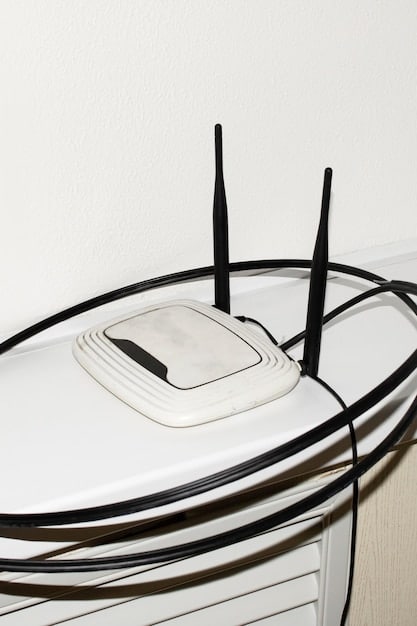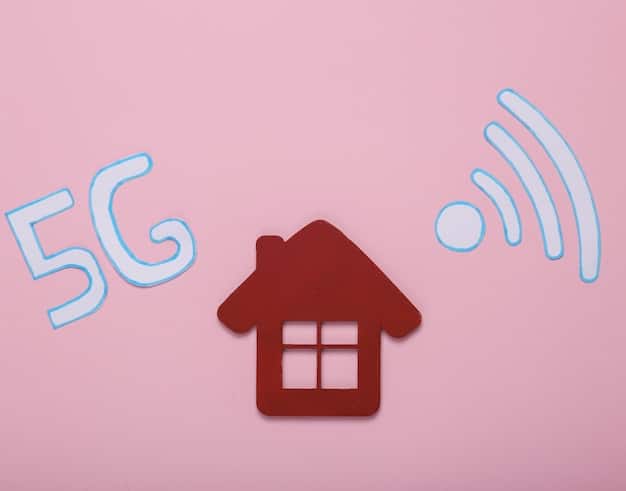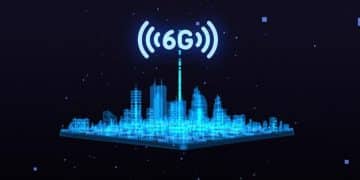5G Home Internet vs Cable: Is 5G a Real Alternative in 2025?

5G home internet is rapidly emerging as a potential alternative to traditional cable internet, but whether it’s a truly viable option in 2025 depends on factors like availability, speed consistency, cost, and individual user needs.
Is 5G home internet truly poised to replace cable as your go-to source for online connectivity in 2025? Let’s explore the realities, cutting through the hype to reveal whether this wireless technology can deliver on its promises.
What is 5G Home Internet?
5G home internet represents a new frontier in wireless connectivity, promising fiber-like speeds without the need for traditional cable infrastructure. This technology utilizes the latest generation of cellular network technology to deliver internet service directly to your home.
Instead of relying on physical cables, 5G home internet uses radio waves to transmit data between a cellular tower and a receiver in your home. This offers a unique advantage, particularly in areas where cable infrastructure is limited or nonexistent.

How Does It Work?
The core principle behind 5G home internet is leveraging the high bandwidth and low latency of 5G cellular networks. A 5G modem or gateway is placed inside your home, typically near a window to optimize signal reception. This device connects wirelessly to a nearby 5G tower, establishing a direct link to the internet.
The gateway then acts as a Wi-Fi router, distributing the internet connection throughout your home to your devices. Unlike traditional cable internet, there’s no need for professional installation, making it a convenient option for many users.
Key Benefits of 5G Home Internet
- Faster Speeds: 5G offers significantly faster speeds compared to older 4G LTE networks, potentially rivaling or even surpassing cable internet speeds in some areas.
- Easy Setup: Self-installation is a major draw, eliminating the need for technician visits and complex wiring.
- Wider Availability: 5G can reach areas where cable internet is not readily available, providing connectivity to underserved communities.
- Competitive Pricing: In some cases, 5G home internet plans can be more affordable than comparable cable internet packages.
In conclusion, 5G home internet offers a compelling alternative to traditional cable internet, especially for those seeking faster speeds, easier setup, and wider availability. However, its performance can be influenced by factors such as tower proximity and network congestion.
5G Home Internet vs. Cable: A Head-to-Head Comparison
Choosing between 5G home internet and cable involves carefully considering various factors, including speed, reliability, cost, and availability. Both technologies have their strengths and weaknesses, making the best choice dependent on your specific needs and location.
Cable internet has long been the dominant player in the home internet market, offering a stable and reliable connection through physical coaxial cables. 5G, on the other hand, is a relatively new entrant, leveraging wireless technology to deliver internet service.

Speed and Performance
Cable internet generally offers consistent speeds, particularly during peak hours. However, 5G speeds can vary depending on factors such as distance from the tower, network congestion, and the capabilities of your 5G modem. While 5G has the potential to deliver faster speeds than cable, real-world performance can be inconsistent.
Latency, or ping rate, is another important factor for online gaming and other real-time applications. Cable internet typically offers lower latency compared to 5G, resulting in a more responsive online experience.
Reliability and Availability
- Cable: Offers a stable connection, but availability is limited to areas with existing cable infrastructure.
- 5G: Availability is expanding rapidly, but signal strength and reliability can be affected by building materials and weather conditions.
Cost and Contracts
Cable internet plans often come with contracts and hidden fees, while 5G providers are increasingly offering contract-free options with straightforward pricing. Promotional offers and bundled services can also influence the overall cost of each option.
Ultimately, the best choice between 5G home internet and cable depends on your individual priorities. If consistent speeds and low latency are paramount, cable may be the better option. However, if you prioritize flexibility, easy setup, and potential cost savings, 5G is worth considering.
Factors Affecting 5G Home Internet Performance in 2025
While 5G home internet holds immense promise, its performance in 2025 will be influenced by several critical factors. Understanding these factors is essential for making an informed decision about whether 5G is the right choice for your home.
One of the primary determinants of 5G performance is network infrastructure. The density of 5G towers in your area, the type of spectrum being used, and the overall capacity of the network all play a significant role.
Network Congestion and Coverage
During peak hours, network congestion can significantly impact 5G speeds. If too many users are sharing the same cellular tower, speeds can slow down considerably. 5G coverage is also not uniform, with some areas experiencing stronger signals than others.
Technological Advancements
- Beamforming: Advanced antenna technologies that focus the 5G signal directly to your device, improving signal strength and reducing interference.
- Network Slicing: Allows operators to allocate specific resources to different applications, ensuring consistent performance for critical services like home internet.
The Impact of Hardware
The quality of your 5G modem or gateway can also affect performance. Devices with better antennas and processing power are more likely to maintain a stable and fast connection.
In short, the performance of 5G home internet in 2025 will depend on a complex interplay of network infrastructure, technological advancements, and hardware capabilities. As 5G networks continue to evolve, performance is expected to improve, but users should carefully consider these factors when making their decision.
Who is 5G Home Internet Right For?
Deciding whether 5G home internet is the right choice for you depends on your specific needs and circumstances. While it offers several advantages, it’s not a one-size-fits-all solution. Let’s explore which types of users are most likely to benefit from 5G.
One of the primary groups who can benefit are those in rural or underserved areas. 5G offers a viable alternative to satellite internet, often providing faster speeds and lower latency at a competitive price.
Ideal Candidates for 5G Home Internet
Here are some user profiles that will benefit from 5G home internet:
- Rural Residents: Where cable is limited or nonexistent, 5G fills the connectivity gap.
- Tech-Savvy Users: Who are comfortable with self-installation and troubleshooting.
- Budget-Conscious Consumers: Seeking an affordable internet option without long-term contracts.
Scenarios Where Cable Might Be Better
Consider these scenarios where cable might be your better option:
- Heavy Gamers: Low latency and reliable speeds are paramount.
- Households with Many Users: Consistent bandwidth is critical for multiple devices streaming simultaneously.
- Demanding Work-From-Home Professionals: Need a stable and dependable internet connection.
Overall, 5G home internet is best suited for users who prioritize flexibility, affordability, and easy setup, especially in areas where cable options are limited. However, those with demanding internet needs may still prefer the reliability of cable.
Potential Challenges and Limitations of 5G Home Internet
Despite its advantages, 5G home internet faces several challenges and limitations that should be considered before making a switch. Understanding these potential drawbacks can help you set realistic expectations and avoid disappointment.
One of the primary challenges is variability in speed and performance. Unlike cable internet, which provides a consistent connection through physical cables, 5G performance can fluctuate based on factors like distance from the tower and network congestion.
Factors Limiting the 5G Experience
Here are some notable limitations:
- Coverage Gaps: 5G coverage is still expanding, with some areas experiencing weaker signals or no coverage at all.
- Weather Interference: Heavy rain or snow can sometimes disrupt the 5G signal, leading to slower speeds or temporary outages.
- Data Caps: Some 5G providers impose data caps, which can limit your internet usage and result in additional charges if you exceed the limit.
Addressing the Challenges
The ongoing rollout of 5G infrastructure, improved signal penetration, and optimized network management are aimed at reducing these limitations.
In conclusion, 5G home internet offers a promising alternative to cable, but it’s essential to be aware of its potential challenges. By understanding these limitations, you can make a more informed decision about whether 5G is the right fit for your home.
The Future of 5G Home Internet: What to Expect in 2025 and Beyond
Looking ahead to 2025 and beyond, 5G home internet is poised for significant growth and evolution. As 5G networks continue to expand and technologies improve, we can expect to see enhanced performance, wider availability, and new applications.
One of the key trends will be the densification of 5G networks. As more 5G towers are deployed, coverage will become more widespread and signal strength will improve, leading to a more consistent and reliable internet experience.
Expected Advancements
Here are some advancements that will improve 5G internet.
• The adoption of mmWave spectrum, which offers ultra-fast speeds but has limited range. As 5G technology matures, mmWave will play a crucial role in delivering gigabit-speed internet to more homes.
• Emerging technologies like artificial intelligence and machine learning will be increasingly used to optimize 5G network performance. AI algorithms can dynamically allocate resources, manage network congestion, and improve signal quality, leading to a better user experience.
With these and other advancements on the horizon, 5G home internet is expected to become an increasingly viable and attractive alternative to traditional cable internet in the years to come. Its flexibility, affordability, and ease of setup will make it a compelling option for a growing number of users.
| Key Point | Brief Description |
|---|---|
| 📡 5G Speeds | Potential for faster download & upload speeds than traditional cable. |
| 🏠 Availability | Expanding rapidly, especially in rural areas where cable is limited. |
| 💰 Cost Savings | Competitive pricing with potentially contract-free options. |
| 📶 Reliability | Affected by network congestion and distance from towers. |
Frequently Asked Questions
▼
While most providers advertise “unlimited” data, some may have data caps or throttle speeds after a certain usage threshold. It’s crucial to read the fine print of your plan.
▼
Generally, no. 5G home internet services typically require using the provider’s modem/router combo unit to ensure compatibility with their network.
▼
Position your 5G gateway near a window and away from obstructions. Check for network outages and ensure your gateway’s firmware is updated.
▼
Yes, 5G home internet is generally safe as long as you use a strong Wi-Fi password and keep your router’s firmware updated to patch security vulnerabilities.
▼
Latency varies, but is generally higher than cable. Expect around 30-50ms, which might not be ideal for competitive online gaming.
Conclusion
In conclusion, 5G home internet presents a compelling alternative to traditional cable, particularly for those in underserved areas or seeking more flexible and affordable options. While it may not yet be a perfect replacement for everyone due to potential performance variations and coverage limitations, ongoing advancements promise a bright future where 5G plays an increasingly significant role in home connectivity.





